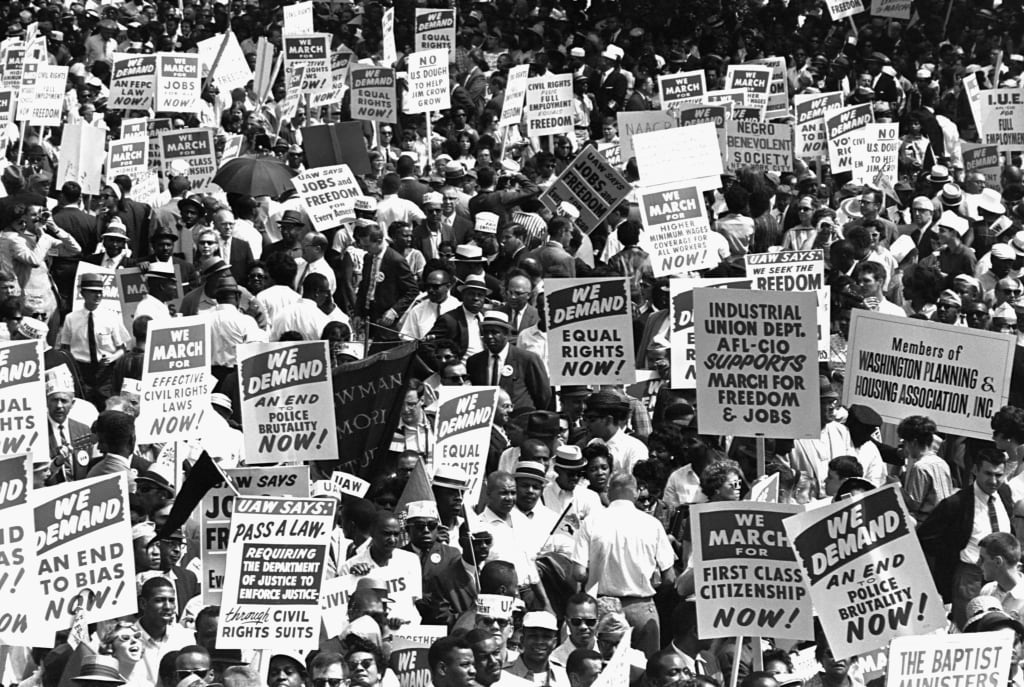The 1960s were an intensely eventful time in American history.
Teeming with various issues regarding race, religion, and war, still, even 50 years later, the 1960s is one of the most newsworthy decades ever. From the Civil Rights Movement to the assassination of John F. Kennedy, to rallies on the war in Vietnam, protest music was everywhere.
Music became a significant factor in voicing anger towards issues or to help cope with the pain. Throughout the years, powerful voices have made their way onto our radios, into our homes, and onto our playlists in forms of rock, hip-hop, and folk music. These are some of the most powerful and political songs of the 1960s.
“A Change Is Gonna Come” by Sam Cooke
Motivated by Bob Dylan’s “Blowin’ in the Wind,” Sam Cooke set out to create his own statement for much-needed change. Cooke, having dealt with racism and discrimination personally, was optimistic that there was room to grow. This hopeful song about being motivated to end prejudice towards certain people because of the colour of their skin was fully embraced by the Civil Rights Movement.
Released in 1964, this was Cooke’s first serious record after a string of pop hits. Taken from his album Ain’t That Good News, the song became a smash hit after his tragic death later that same year.
“Blowin’ in the Wind” by Bob Dylan
Despite continuously denying that his songs were written without any revolting implications in mind, Bob Dylan is a figure that has become synonymous with protest music. During the early 1960s, folk music reached its peak across America. With this boost in popularity, Dylan was thrust into the limelight. “Blowin’ in the Wind” was just one of his great works that grew into something completely untouchable.
TIME magazine dubbed it “an anthem for the whole lost crowd he speaks for.” This anthem helped unite a movement that would define the 1960s; civil rights. The classic was taken from his second album, The Freewheelin’ Bob Dylan, which was released in 1963, a year before the Civil Rights Act was eventually passed.
Along with many other Dylan standards, “Blowin’ in the Wind” gets the audience to look inside at the deeper meaning. Other notable folk artists to have covered this iconic song were Joan Baez and Peter, Paul and Mary. Even with Dylan’s hesitance on speaking out politically, his music will forever remain closely linked to the changing times of the 1960s.
“For What It’s Worth” by Buffalo Springfield
Although most associate this song with the Kent State shooting in 1970, “For What It’s Worth” was actually inspired by another event. The Sunset Strip curfew riots of November 1966 originated from young people that frequented the area being annoyed by the curfew put in place. Around that time, Buffalo Springfield had just become the house band at the famous Whisky a Go-Go on the Sunset Strip.
This curfew was to help stop late-night traffic congestion around the area. Many thought the laws infringed on their civil rights. Around a thousand demonstrators came to show their displeasure with the new law on a day in mid-November. The protest started peacefully but tensions inevitably arose and lasted throughout the rest of the year.
“Give Peace A Chance” by the Plastic Ono Band
Even as part of the Beatles, John Lennon was voicing his opinion about the never-ending war in Vietnam. Following John and Yoko’s famous Bed-In to promote peace, the song was officially released in 1969 after recording it in their hotel room. Joined in their Montreal suite to help record were Timothy Leary, Allen Ginsberg, Tommy Smothers, and many more.
The message of the song is inherently clear: Give peace a chance. It’s simple and easy to sing along to. It’s no wonder how it became one of the most popular songs from the anti-Vietnam movement.
“Say It Loud – I’m Black and I’m Proud” by James Brown
This popular funk song of 1968 grew into being the unofficial Black Power movement of the late 1960s. By the latter part of the decade, nonviolent groups were surpassed by radical groups like the Black Panther Party due to the frustration that the Civil Rights Movement wasn’t progressing fast enough.
James Brown was a leader in the Black community. The song came to fruition after Brown witnessed a disagreement among a group of Black citizens in Los Angeles. After the death of Martin Luther King Jr., several people had nowhere to turn. “Say It Loud – I’m Black and I’m Proud” lifted the spirits of many and opened up the doors to what Black empowerment stood for.

